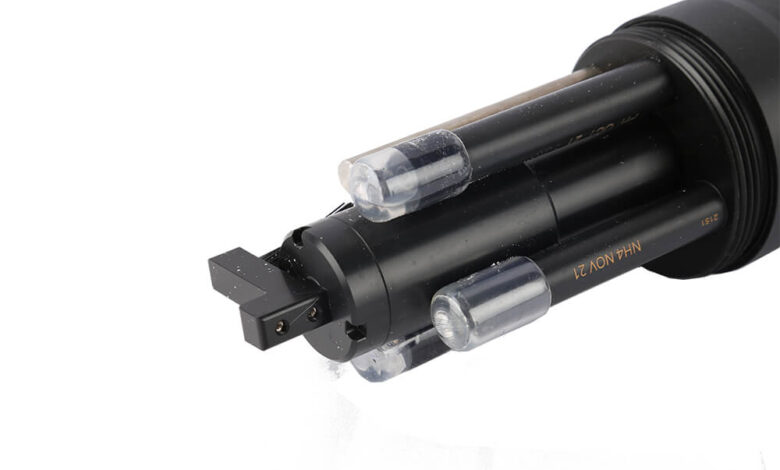How Ammonium Sensors are Revolutionizing Wastewater Treatment Plants

Table of Contents
ToggleWastewater treatment is an essential process for maintaining water quality and protecting public health. One of the most significant challenges in wastewater management is the presence of ammonium (NH₄⁺), a nitrogen-based compound that can cause environmental damage if released into natural water systems. High concentrations of ammonium in effluent can lead to water pollution, How Ammonium Sensors are Revolutionizing Wastewater Treatment Plants eutrophication, and the depletion of oxygen in aquatic ecosystems. To address this issue, wastewater treatment plants are increasingly turning to Ammonium sensor to improve treatment processes, ensure regulatory compliance, and protect water quality.
In this blog post, we’ll explore the role of ammonium sensors in wastewater treatment plants, how they work, their benefits, and their impact on the industry.
The Importance of Ammonium in Wastewater Treatment
Ammonium is commonly found in wastewater due to the breakdown of organic matter, human waste, and agricultural runoff. If left untreated or inadequately managed, ammonium in wastewater can lead to severe environmental consequences:
1. Eutrophication
When ammonium enters water bodies, it contributes to eutrophication, a process in which excess nutrients cause the overgrowth of algae. These algae blooms deplete oxygen in the water, leading to hypoxic conditions that suffocate aquatic life. This can result in fish kills, loss of biodiversity, and degraded water quality.
2. Toxicity to Aquatic Life
High concentrations of ammonium can be toxic to fish and other aquatic organisms, particularly in freshwater systems. Ammonium toxicity disrupts the gill function of aquatic life, leading to decreased survival rates and impacting entire ecosystems.
3. Public Health Concerns
Ammonium is a key component of nitrogen compounds that can enter drinking water supplies. Long-term exposure to elevated nitrogen levels, including ammonium, can pose health risks, particularly for infants, who are more vulnerable to conditions such as methemoglobinemia, also known as “blue baby syndrome.”
To prevent these issues, wastewater treatment plants must remove ammonium from effluent before it is discharged into rivers, lakes, or oceans. Ammonium sensors play a crucial role in ensuring that the treatment processes effectively reduce ammonium concentrations to safe levels.
How Ammonium Sensors Work in Wastewater Treatment
Ammonium sensors are specialized devices designed to measure the concentration of ammonium ions in water. These sensors provide real-time data that can be used to monitor effluent quality continuously, ensuring compliance with environmental standards. There are two main types of ammonium sensors used in wastewater treatment: electrochemical sensors and optical sensors.
1. Electrochemical Sensors
Electrochemical ammonium sensors measure the concentration of ammonium by detecting the changes in electrical properties when ammonium ions interact with the sensor’s electrode. As ammonium ions are attracted to the electrode, they cause a shift in current or voltage. This shift is proportional to the concentration of ammonium in the sample, allowing for accurate and real-time measurement. Electrochemical sensors are commonly used in wastewater treatment plants due to their reliability and cost-effectiveness.
2. Optical Sensors
Optical ammonium sensors use light to measure ammonium concentration. The sensor emits light through the sample and measures how much light is absorbed or scattered by ammonium ions. Ammonium absorbs light at specific wavelengths, and this absorption is analyzed to determine the concentration of ammonium in the water. Optical sensors are often preferred for environmental monitoring, as they are non-invasive and can provide continuous data without requiring direct contact with the sample.
Both types of sensors are integral to ensuring the accuracy and efficiency of ammonium removal in wastewater treatment processes.
Key Applications of Ammonium Sensors in Wastewater Treatment Plants
Ammonium sensors are increasingly being implemented in wastewater treatment plants worldwide to optimize treatment processes, reduce environmental impact, and ensure compliance with regulatory standards. Here are some of the primary applications of ammonium sensors in wastewater treatment:
1. Real-Time Monitoring of Effluent Quality
One of the most critical applications of ammonium sensors in wastewater treatment is continuous monitoring of effluent quality. By measuring ammonium concentrations in real-time, wastewater treatment plants can quickly detect any increases in ammonium levels and take corrective action before the effluent is released into the environment. This real-time data also helps plant operators track the performance of treatment processes and make adjustments as needed to improve efficiency.
Benefits:
-
Immediate Action: Ammonium sensors provide early warning signals when ammonium levels exceed acceptable thresholds, allowing for immediate corrective actions.
-
Increased Efficiency: Continuous monitoring helps optimize treatment processes, ensuring that ammonium is effectively removed from wastewater.
-
Regulatory Compliance: Ammonium sensors help ensure that effluent meets environmental discharge standards, reducing the risk of fines and regulatory penalties.
2. Optimizing Nitrification and Denitrification Processes
Wastewater treatment plants typically rely on biological processes such as nitrification and denitrification to remove ammonium. Nitrification involves the conversion of ammonium to nitrate by nitrifying bacteria, while denitrification converts nitrate to nitrogen gas. Both processes require careful control of environmental conditions to function optimally.
Ammonium sensors help optimize these processes by providing real-time data on ammonium concentrations, enabling plant operators to fine-tune aeration, pH, and other variables. By ensuring that the nitrification and denitrification processes occur efficiently, ammonium sensors help minimize the overall treatment time and reduce the energy costs associated with wastewater treatment.
Benefits:
-
Improved Treatment Efficiency: Accurate monitoring of ammonium levels ensures that nitrification and denitrification processes are carried out optimally, leading to faster and more efficient ammonium removal.
-
Reduced Energy Costs: By optimizing treatment processes, ammonium sensors help reduce the energy required for aeration and other processes.
-
Cost Savings: Efficient ammonium removal reduces the need for additional chemical treatment and ensures that the treatment plant operates at maximum efficiency.
3. Preventing Ammonium Toxicity in Receiving Waters
Ammonium is toxic to aquatic life, and untreated or inadequately treated wastewater can cause significant harm to receiving water bodies. By using ammonium sensors, wastewater treatment plants can ensure that ammonium concentrations are reduced to safe levels before effluent is discharged. This prevents toxicity and protects aquatic ecosystems from the harmful effects of ammonium pollution.
Benefits:
-
Environmental Protection: Ammonium sensors help prevent the release of toxic levels of ammonium into natural water bodies, preserving aquatic life and biodiversity.
-
Improved Water Quality: By monitoring ammonium concentrations, wastewater treatment plants help maintain the quality of rivers, lakes, and coastal waters.
-
Sustainable Operations: Preventing ammonium pollution supports the long-term health of aquatic ecosystems and reduces the need for costly environmental remediation efforts.
4. Supporting Regulatory Compliance and Reporting
Wastewater treatment plants are subject to strict environmental regulations that limit the amount of ammonium that can be discharged into water bodies. Ammonium sensors help ensure that treatment plants meet these regulatory requirements by providing accurate and continuous data on effluent quality. This data can be used for compliance reporting and audits. Ensuring that plants adhere to local and international environmental standards.
Benefits:
-
Documentation and Reporting. Ammonium sensors provide accurate. Data that can be used for compliance reporting. Helping treatment plants meet regulatory requirements.
-
Reduced Risk of Penalties: Real-time monitoring ensures that effluent quality is consistently within acceptable limits, reducing the risk of fines or legal action.
-
Enhanced Transparency: Continuous monitoring and data collection improve transparency in wastewater management, providing stakeholders with a clear view of treatment plant operations.
The Future of Ammonium Sensors in Wastewater Treatment
The role of ammonium sensors. Wastewater treatment is expected to expand as. The demand for more efficient, sustainable, and environmentally friendly wastewater management grows. Advances in sensor technology will likely lead to even more accurate, affordable, and user-friendly ammonium sensors. Furthermore, the integration of ammonium sensors with IoT (Internet of Things) platforms will enable remote monitoring, predictive analytics, and automation in wastewater treatment plants, further enhancing their ability to optimize treatment processes and reduce environmental impact.
Conclusion
Ammonium sensors are transforming the wastewater treatment industry by providing real-time, accurate data on ammonium concentrations in effluent. These sensors help optimize treatment processes, ensure compliance with environmental regulations, and protect water quality. By enabling more efficient ammonium removal, reducing toxicity, and preventing eutrophication, ammonium sensors play a vital role in ensuring sustainable wastewater management practices.
As wastewater treatment plants continue to embrace sensor technology, ammonium sensors will become increasingly integral in maintaining clean, safe water resources for future generations.


